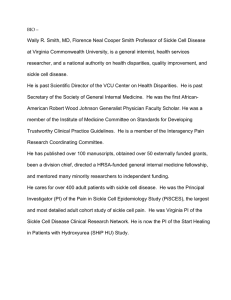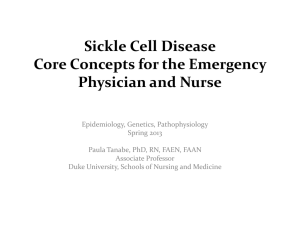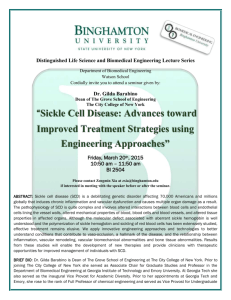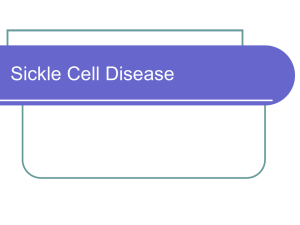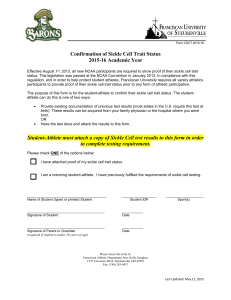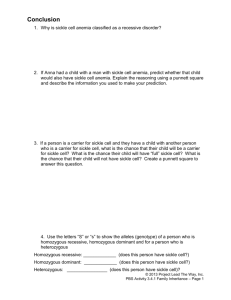Sickle cell diseases (SCD), due mostly to homozygous hemoglobin S... compound heterozygosity of HbS and HbC or ß-thalassemia, are multisystem
advertisement
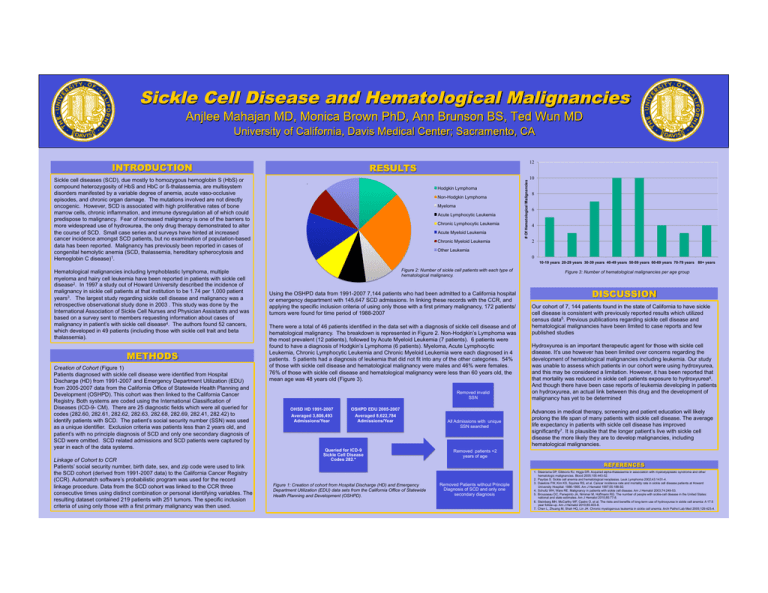
Sickle cell diseases (SCD), due mostly to homozygous hemoglobin S (HbS) or compound heterozygosity of HbS and HbC or ß-thalassemia, are multisystem disorders manifested by a variable degree of anemia, acute vaso-occlusive episodes, and chronic organ damage. The mutations involved are not directly oncogenic. However, SCD is associated with high proliferative rates of bone marrow cells, chronic inflammation, and immune dysregulation all of which could predispose to malignancy. Fear of increased malignancy is one of the barriers to more widespread use of hydroxurea, the only drug therapy demonstrated to alter the course of SCD. Small case series and surveys have hinted at increased cancer incidence amongst SCD patients, but no examination of population-based data has been reported. Malignancy has previously been reported in cases of congenital hemolytic anemia (SCD, thalassemia, hereditary spherocytosis and Hemoglobin C disease)1. Hematological malignancies including lymphoblastic lymphoma, multiple myeloma and hairy cell leukemia have been reported in patients with sickle cell disease2. In 1997 a study out of Howard University described the incidence of malignancy in sickle cell patients at that institution to be 1.74 per 1,000 patient years3. The largest study regarding sickle cell disease and malignancy was a retrospective observational study done in 2003 . This study was done by the International Association of Sickle Cell Nurses and Physician Assistants and was based on a survey sent to members requesting information about cases of malignancy in patient’s with sickle cell disease4. The authors found 52 cancers, which developed in 49 patients (including those with sickle cell trait and beta thalassemia). Creation of Cohort (Figure 1) Patients diagnosed with sickle cell disease were identified from Hospital Discharge (HD) from 1991-2007 and Emergency Department Utilization (EDU) from 2005-2007 data from the California Office of Statewide Health Planning and Development (OSHPD). This cohort was then linked to the California Cancer Registry. Both systems are coded using the International Classification of Diseases (ICD-9- CM). There are 25 diagnostic fields which were all queried for codes (282.60, 282.61, 282.62, 282.63, 282.68, 282.69, 282.41, 282.42) to identify patients with SCD. The patient’s social security number (SSN) was used as a unique identifier. Exclusion criteria was patients less than 2 years old, and patient’s with no principle diagnosis of SCD and only one secondary diagnosis of SCD were omitted. SCD related admissions and SCD patients were captured by year in each of the data systems. Linkage of Cohort to CCR Patients’ social security number, birth date, sex, and zip code were used to link the SCD cohort (derived from 1991-2007 data) to the California Cancer Registry (CCR). Automatch software’s probabilistic program was used for the record linkage procedure. Data from the SCD cohort was linked to the CCR three consecutive times using distinct combination or personal identifying variables. The resulting dataset contained 219 patients with 251 tumors. The specific inclusion criteria of using only those with a first primary malignancy was then used. Hodgkin Lymphoma Non-Hodgkin Lymphoma Myeloma Acute Lymphocytic Leukemia Chronic Lymphocytic Leukemia Acute Myeloid Leukemia Chronic Myeloid Leukemia # Of Hematological Malignancies 12 10 8 6 4 2 Other Leukemia 0 10-19 years 20-29 years 30-39 years 40-49 years 50-59 years 60-69 years 70-79 years 80+ years Figure 2: Number of sickle cell patients with each type of hematological malignancy. Using the OSHPD data from 1991-2007 7,144 patients who had been admitted to a California hospital or emergency department with 145,647 SCD admissions. In linking these records with the CCR, and applying the specific inclusion criteria of using only those with a first primary malignancy, 172 patients/ tumors were found for time period of 1988-2007 There were a total of 46 patients identified in the data set with a diagnosis of sickle cell disease and of hematological malignancy. The breakdown is represented in Figure 2. Non-Hodgkin’s Lymphoma was the most prevalent (12 patients), followed by Acute Myeloid Leukemia (7 patients). 6 patients were found to have a diagnosis of Hodgkin’s Lymphoma (6 patients). Myeloma, Acute Lymphocytic Leukemia, Chronic Lymphocytic Leukemia and Chronic Myeloid Leukemia were each diagnosed in 4 patients. 5 patients had a diagnosis of leukemia that did not fit into any of the other categories. 54% of those with sickle cell disease and hematological malignancy were males and 46% were females. 76% of those with sickle cell disease and hematological malignancy were less than 60 years old, the mean age was 48 years old (Figure 3). Removed invalid SSN OHSD HD 1991-2007 Averaged 3,806,493 Admissions/Year OSHPD EDU 2005-2007 Averaged 8,622,784 Admissions/Year Queried for ICD-9 Sickle Cell Disease Codes 282.* Figure 1: Creation of cohort from Hospital Discharge (HD) and Emergency Department Utilization (EDU) data sets from the California Office of Statewide Health Planning and Development (OSHPD). All Admissions with unique SSN searched Figure 3: Number of hematological malignancies per age group Our cohort of 7, 144 patients found in the state of California to have sickle cell disease is consistent with previously reported results which utilized census data5. Previous publications regarding sickle cell disease and hematological malignancies have been limited to case reports and few published studies Hydroxyurea is an important therapeutic agent for those with sickle cell disease. It’s use however has been limited over concerns regarding the development of hematological malignancies including leukemia. Our study was unable to assess which patients in our cohort were using hydroxyurea, and this may be considered a limitation. However, it has been reported that that mortality was reduced in sickle cell patients exposure to hydroxyurea6. And though there have been case reports of leukemia developing in patients on hydroxyurea, an actual link between this drug and the development of malignancy has yet to be determined Advances in medical therapy, screening and patient education will likely prolong the life span of many patients with sickle cell disease. The average life expectancy in patients with sickle cell disease has improved significantly7. It is plausible that the longer patient’s live with sickle cell disease the more likely they are to develop malignancies, including hematological malignancies. Removed patients <2 years of age Removed Patients without Principle Diagnosis of SCD and only one secondary diagnosis 1. Steensma DP, Gibbons RJ, Higgs DR. Acquired alpha-thalassemia in association with myelodysplastic syndrome and other hematologic malignancies. Blood 2005;105:443-52. 2. Paydas S. Sickle cell anemia and hematological neoplasias. Leuk Lymphoma 2002;43:1431-4. 3. Dawkins FW, Kim KS, Squires RS, et al. Cancer incidence rate and mortality rate in sickle cell disease patients at Howard University Hospital: 1986-1995. Am J Hematol 1997;55:188-92. 4. Schultz WH, Ware RE. Malignancy in patients with sickle cell disease. Am J Hematol 2003;74:249-53. 5. Brousseau DC, Panepinto JA, Nimmer M, Hoffmann RG. The number of people with sickle-cell disease in the United States: national and state estimates. Am J Hematol 2010;85:77-8. 6. Steinberg MH, McCarthy WF, Castro O, et al. The risks and benefits of long-term use of hydroxyurea in sickle cell anemia: A 17.5 year follow-up. Am J Hematol 2010;85:403-8. 7. Chen L, Zhuang M, Shah HQ, Lin JH. Chronic myelogenous leukemia in sickle cell anemia. Arch Pathol Lab Med 2005;129:423-4.
